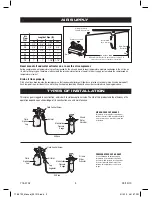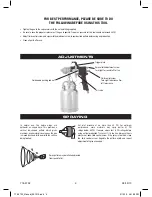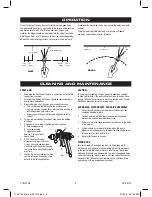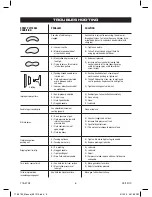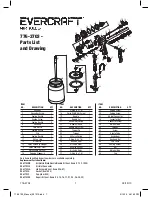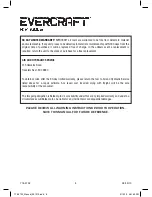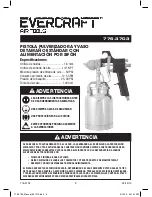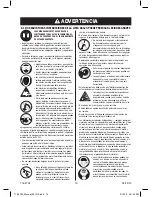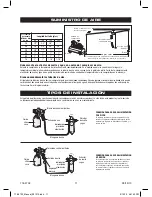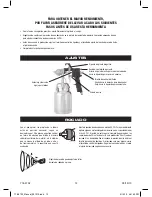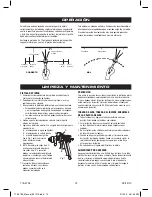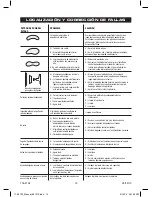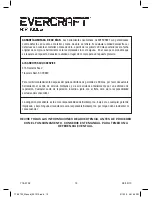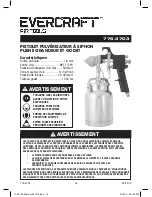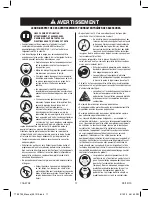
776-3703
2
09/13/10
reAd this instruction MAnuAl cArefully
And understAnd All inforMAtion before
operAting this tool.
• Always operate, inspect and maintain this tool in accordance with
American National Standards Institute Safety Code of Portable Air
Tools (ANSI B186.1) and any other applicable safety codes and
regulations..
• During cleaning and flushing, sol vents can be
forcefully expelled from fluid and air
passages. Some solvents can cause eye injury.
• Be sure all in the area are wearing im pact-
resistant eye and face protection.
• Even small projectiles can in jure eyes and
cause blind ness.
• High sound levels can cause per ma nent hear ing
loss. Protect your self from noise. Noise levels
vary with work sur face. Wear ear pro tec tion.
• Repetitive work motions, awk ward po si tions and
ex po sure to vibration can be harm ful to hands
and arms.
• Air under pressure can cause severe injury.
Al ways shut off air supply, drain hose of air
pres sure and dis con nect tool from air supply
when not in use, be fore chang ing ac ces so ries
or when mak ing re pairs. Nev er di rect air at
your self or anyone else. Whip ping hos es can
cause serious injury. Al ways check for damaged
or loose hoses and fit tings. Never use quick
change cou plings at tool. They add weight and
could fail due to vi bra tion. In stead, add a hose
whip and con nect cou pling be tween air sup ply
and hose whip, or be tween hose whip and
leader hose. Do not ex ceed max i mum air inlet
pres sure of 50 PSI.
• Always use tool at a safe distance from other peo ple
in work area.
• Maintain tools with care. Keep tools clean and oiled for best
and safest performance. Follow in struc tions for lu bri cat ing
and chang ing ac ces so ries. Wiping or clean ing rags and other
flam ma ble waste materials must be placed in a tight ly closed
metal con tain er and disposed of later in the prop er fash ion.
• Do not wear loose or ill-fit ting clothing; re move watch es
and rings.
• Do not over reach. Keep prop er footing and
bal ance at all times. Slip ping, trip ping and
falling can be a ma jor cause of se ri ous in ju ry
or death. Be aware of excess hose left on the
walk ing or work sur face.
• Do not force tool. It will do the job better and
safer at the rate for which it was de signed.
• Do not abuse hoses or con nec tors. Never carry
tool by the hose or yank hose to dis con nect
from air sup ply. Keep hoses from heat, oil and
sharp edg es. Check hoses for weak or worn
condition before each use, mak ing cer tain that
all con nec tions are se cure.
• When possible, secure work with clamps or vise so both hands
are free to op er ate tool.
• Avoid inhaling dust or han dling de bris from
work processes which can be harmful to your
health.
• Operators and maintenance per son nel must be
phys i cal ly able to handle the bulk, weight and
power of this tool.
• This tool is not intended for us ing in ex plo sive at mospheres and
is not insulated for contact with electric power sources.
• Solvent and coatings can be highly flam ma ble
or com bus ti ble, especially when sprayed.
Adequate exhaust must be pro vid ed to keep air
free of ac cu mu la tions of flam ma ble vapors.
• Smoking must never be allowed in the spray area.
• Fire extinguishing equipment must be present in the spray area.
• Never spray near sources of ignition such as pilot lights,
welders, etc.
• Halogenated hydrocarbon sol vents — for example, me th yl ene
chloride — are not chem i cal ly compatible with the alu mi num
that might be used in many system com po nents. The chemical
re ac tion caused by these solvents reacting with aluminum can
be come violent and lead to an equip ment explosion. Guns with
stain less steel fluid passages may be used with these sol vents.
How ev er, aluminum is widely used in other spray ap plica tion
equipment - such as material pumps, cups and reg u la tors,
valves, etc. Check all other equipment items be fore use and
make sure they can also be used safely with these solvents.
Read the label or data sheet for the ma te ri al you intend to spray.
If in doubt as to whether or not a coating or cleaning ma te ri al is
com pat i ble, contact your ma te ri al supplier.
• Sprayed materials may be harm ful if in haled,
or if there is contact with the skin. Adequate
exhaust must be pro vid ed to keep the air
free of ac cu mu la tions of toxic ma te ri als.
Use a mask or res pi ra tor when ev er there is a
chance of in hal ing sprayed ma te ri als. The mask
must be com pat i ble with the material being
sprayed and its con cen tra tion.
WARNING
FAILURE TO OBSERVE THESE WARNINGS COULD RE SULT IN IN JU RY.
776-3703_Manual_091310.indd 2
9/13/10 4:41:36 PM



